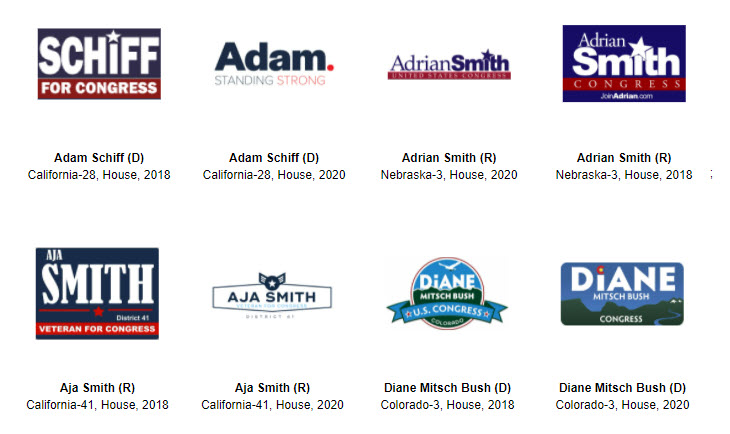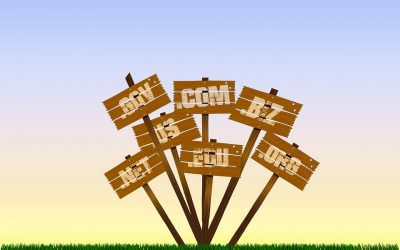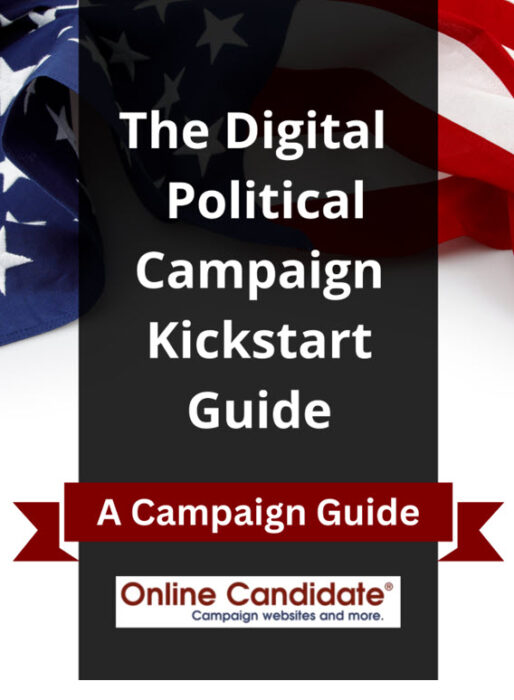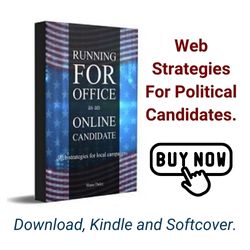When a State Flag or Local Emblem Causes Trouble
 Are you planning to spruce up your campaign website with a dash of local flavor, like your state flag or a municipal emblem? Well, hold on, because you might be stepping on a legal landmine without even knowing it.
Are you planning to spruce up your campaign website with a dash of local flavor, like your state flag or a municipal emblem? Well, hold on, because you might be stepping on a legal landmine without even knowing it.
It’s possible that the state flag or local municipal emblem you want to include in your campaign website might become a problem with the election board. Using state or local graphics may violate local election laws.
Laws vary on rules regarding the use of official symbols on political websites and campaign material. Many candidates opt for landmark or scenic images in their website headers. Other candidates who choose to include a background image of their state flag or municipal emblem.
Campaigns that want to design their sites with flag or emblem images should double-check for any state or local regulations on how those emblems can be used in campaign materials. (We often use these emblems as subtle background watermarks.) Laws and regulations vary, and it’s better to do things right the first time than to get called out later for an infraction.
The same issue can apply to official county seals or seals of local government. For example, candidates may be prohibited from using a sheriff’s department insignia or badge. If you’re a candidate with a military background, there are restrictions on when you can strut your stuff in uniform for political purposes. Judges tend to have the heaviest restrictions on what insignias and imagery they can use.
As an aside, we encountered a reverse situation a few years back. During a local election, an incumbent actually put his head shot into the website header of the town website, essentially branding the municipal website for his own purposes. After some public outcry, the head shot was removed.
What’s at stake? If you ignore local election laws, you’re asking for trouble and could even face legal repercussions. Fines, penalties, and possibly the loss of credibility. It’s not a game you want to play lightly.
Before you go wild with those state flags and emblems, make sure you understand your local election laws inside and out. We can’t stress this enough. Avoid being the candidate that lands in hot water for a graphic blunder.
In a nutshell, keep your campaign materials compliant, your designs captivating, and your reputation intact. It’s not hard, but it’s a critical part of having a clean and successful campaign!
For more campaign tips and ideas, check out OnlineCandidateResources.com. Access is free for Online Candidate campaign website clients.
Designing a Winning Political Logo – Tips and Ideas
A great logo design is central to a political candidate’s branding. It must be unique and stand out enough to establish a candidate to a wide audience. A well-designed political logo is a major element in projecting a professional brand in the minds of voters. Your branding can be a crucial component to fundraising and building a following.
Campaign logos provide a visual identity. They can be used on yard signs, candidate brochures, direct mailings, palm cards, video ads and all other forms of political advertising. An amateur-looking design reflects poorly on your candidacy and will keep voters from taking you seriously.
Table of Contents
- Political Logo Design Tips
- Current Design Trends
- Making Your Own Political Logo
- Sheriff Campaigns
- Judicial Campaigns
- School Board Campaigns
- Who Will Make Your Logo?
Our custom political website packages include professional logo creation – AND we’ll provide a FREE high-res version for your print materials.
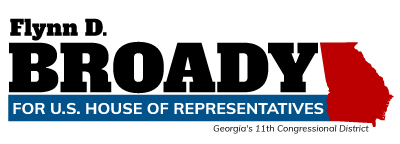
House of Representatives logo example with graphic in the design.
Tips for creating a winning campaign logo
One of the first steps to establishing your campaign branding is to invest time in your logo design. Employing visual elements such as color and fonts help voters understand your message and helps project a clear and consistent message.
Here are some tips to achieve the best look and layout when making a campaign logo.
Incorporating typography and text
Sans-serif fonts tend to dominate political communication. That’s no surprise, as sans-serif fonts tend to appear more conventional and project stability. Serif fonts, on the other hand, tend to appear more happy and casual. Script lettering is much harder to read and may not translate as well to print.
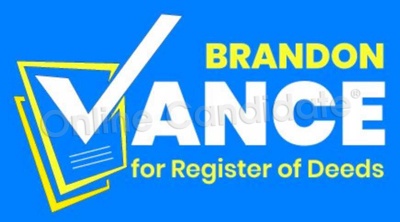
Here the first letter of the logo has been changed to a checkbox.
Choosing the right campaign colors
Choose your logo colors carefully. Many of our clients pick a red/white/blue flag color scheme. State or local candidates often match their state flag colors. Black and white or yellow are the most common colors for judges, sheriff, and law enforcement candidates. Odd colors like purple or pink may get attention but may also distract from the overall messaging.
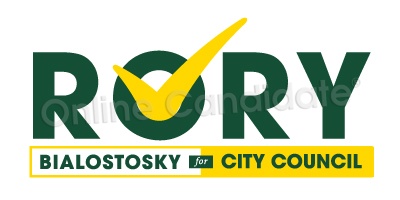
Campaign logo for city council in yellow and green colors sets it apart from the traditional political red and blue.
In the United States, it is traditional for political logos to have a red, white and blue color scheme. Blue is more popular for Democratic candidates, whereas red is significantly preferred by Republicans. To stand out, third party candidates often use other colors like green or orange.
The psychology behind branding
There is a psychology behind brand design. For example, the way a brand is designed with color can have a big effect on how voters see a candidate. For example, blue is often associated with trust, loyalty, and professionalism. In contrast, red is often associated with excitement, passion, and urgency.
Even the choice of font can influence how voters think of a candidate. Serif fonts, for example, are often associated with tradition. Using a traditional serif font in your logo may make you appear more reliable, established, and trustworthy.
Sans-serif fonts are often associated with modernity and simplicity. Sans-serif fonts are often used in websites and apps and are considered more legible in smaller sizes. Using sans-serif fonts in your logo can communicate a sense of innovation and progressiveness for your campaign.
These are just a few examples of the psychology behind brand design. By understanding how your voters might perceive these different design elements, your campaign can create a brand identity that will identify with your target voting block and help your stand.
Use symbols for better logo branding
Know the rules. Political campaign design often incorporates patriotic symbols or icons, such as an eagle, stars, political party symbols or state flags. You might not be able to include political party logos, either. There may be local rules or laws that prohibit what can appear on signage or campaign websites. Learn the restrictions on what you can and cannot include in your branding, so you don’t run into problems later.
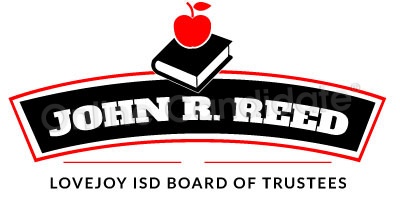
Keep consistency in your design
Once you have your logo designed, don’t change it halfway through the race. A good part of voter branding is in your logo, and if you change it at some point, you’ll lose much of that connection.
NOTE: Your existing campaign logo design may not translate well to web. If you already have your print material created, it will probably need to be tweaked a bit to make it work online. For example, your design may have a border on it. That may look great on a sign, but it may look blocky when used in a website header. Sometimes we will remove borders or tweak the layout to flow better with a candidate’s head shot or background image.
The goal of great political design is for the average voter to immediately recognize your brand no matter where they see it.
Designing your own political logo
We strongly advise having someone with graphic design experience create your politician logo. Some people think they can save money and make a logo themselves, but often the results are amateurish. There may be spacing issues, or graphics not integrated well with the text, or layout is just too long or too tall. Sometimes the graphic element goes too far and makes the image look too complicated.
The best political campaign logos are simple enough to stand out, without being complicated with unnecessary elements.
Free campaign logo design tools
Free logo makers can sometimes do the job. They often include basic templates. But the image editor in a logo maker is only as good as the person using the tool. Also watch out – free logo generators only provides a low-res graphic for you. This can work fine for web purposes, but will look blurry in print. You’ll need to pay for a higher-resolution version that will scale for your printed materials, such as signs or brochures.
For inspiration, check out our own political logo examples.
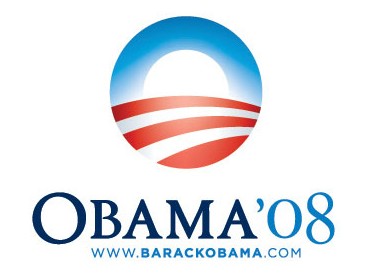
The “Hope” image, designed by artist Shepard Fairey, became an iconic image during Barack Obama’s 2008 presidential campaign.
Current political graphic trends
The Center for American Politics and Design (CAPD) collects branding designs for US House, Senate, Presidential and Gubernatorial races. The archive is a tool that allows users to filter and examine different graphic elements. It has been updated to 2020.
There has been more use of script and signature logos in recent years. They can be eye-catching, but should be used carefully so they remain legible.

Image and graphic elements are also added for visual interest. Incorporating a flag, state or federal building or even a state graphic is something we’ve done for years. Visual elements such as heartbeats for doctor candidates and bells and shields for ex-military candidates have become more common. We’ve seen an expansion in these types of elements in recent years.
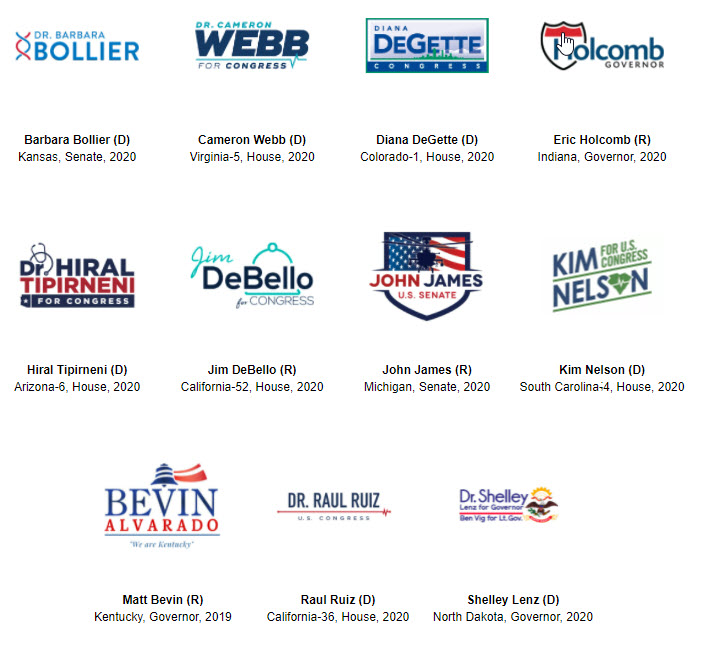
Boxes are still popular, and they’ve increased in popularity with Republicans – especially the stars along the top border. These work well for sign use, but sometimes it’s better to remove the outer box for online use, especially in the site header. Sometimes, the box is slanted at an angle, which gives the design a sense of movement and energy. This look started gaining popularity with Alexandria Ocasio-Cortez’s 2018 House of Representatives campaign. It’s been imitated by other progressive candidates, including a number of our own clients.
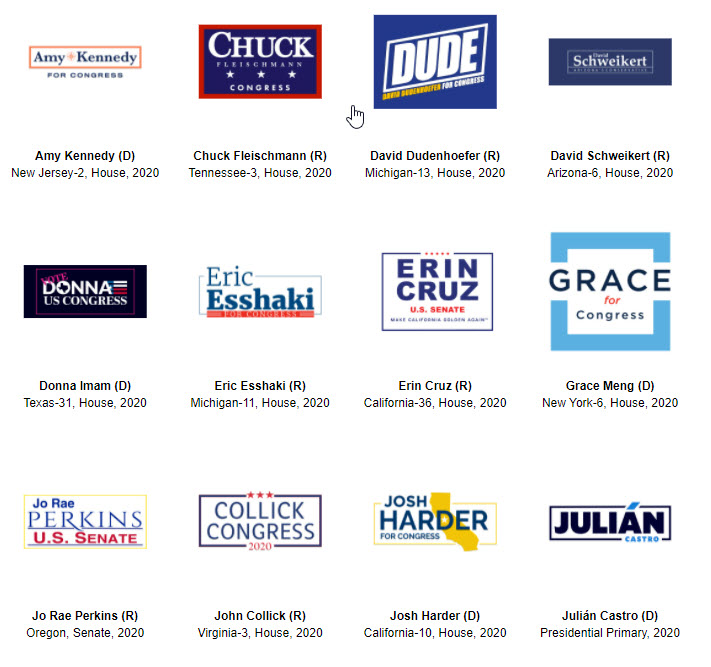
Some politicians perform a brand refresh between election campaigns. Here are a few examples:
Sheriff Logos – Stars and Badges
 Campaign logos for sheriffs tend to be ‘blocky’ with large lettering. Black, gold and white tend to be popular colors for law enforcement candidates. Sheriff logos often incorporate a six-point badge of some type (but not an official government badge). Sheriff candidates are often not allowed to even appear in promotional material wearing official law enforcement uniforms or insignias. Any badges that are used are often generic, or with identifying text removed.
Campaign logos for sheriffs tend to be ‘blocky’ with large lettering. Black, gold and white tend to be popular colors for law enforcement candidates. Sheriff logos often incorporate a six-point badge of some type (but not an official government badge). Sheriff candidates are often not allowed to even appear in promotional material wearing official law enforcement uniforms or insignias. Any badges that are used are often generic, or with identifying text removed.
Related: Sheriff Campaign Logo Design
Judicial Logos – Gavels and Scales
 Logos for judges tend to be clean. They may have a gavel integrated into the logo, or there might be scales of justice worked in. Judicial logos tend to be dark and serious. Block lettering is standard. As they are nonpolitical, a judge logo is typically not the usual red, white and blue in traditional US politics. The overall look of the print materials and website tend to carry the look of a law firm – lots of blacks and whites with the occasional accent of color.
Logos for judges tend to be clean. They may have a gavel integrated into the logo, or there might be scales of justice worked in. Judicial logos tend to be dark and serious. Block lettering is standard. As they are nonpolitical, a judge logo is typically not the usual red, white and blue in traditional US politics. The overall look of the print materials and website tend to carry the look of a law firm – lots of blacks and whites with the occasional accent of color.
Related: Judicial Campaign Logo Design
School Board Logos – Mortar Boards and Apples

Simple images within a campaign logo can help tell a story. For example, an apple in a logo suggests a candidate for school board.
Logos for school board candidates can vary widely. They may often incorporate books, mortar boards or apples into them. School board logo colors often match the local high school or primary educational facility. If you have a particularly large school or high school that dominates the district, you may want to incorporate those particular colors into your branding.
Related: School Board Campaign Logo Design
Who Will Make Your Logo?
 Many smaller campaigns have their logo created by a print shop when they produce their first mailing. Others may have a volunteer make a design, or hire a professional graphic designer to do the job.
Many smaller campaigns have their logo created by a print shop when they produce their first mailing. Others may have a volunteer make a design, or hire a professional graphic designer to do the job.
No matter who creates the design, you will want to have a high-resolution version to use for other purposes. This means the image is saved at 300 dpi in a jpg, tif, png, or eps format. High resolution makes it better for print pieces, such as mailers and signs.
Some of our clients already have their design assets when start their website. If client does not have one, or wants a better one, we will create a logo for them.
For graphic artists, we also provide customizable design templates. We offer downloadable Adobe Illustrator and Photoshop logo templates and a variety of Canva political logos.
Our Regular and Enhanced Political Website Packages includes free custom logo design and header. We’ll also provide high-res version for your print material. Why pay hundreds to have a designer do this? We’ll make one for you – and it’s included with your website.
Squeezing The Most From Your Campaign Landing Pages
 In the world of online marketing, building a targeted email list allows the merchant to market their product and service to this select group with a higher degree of success. The same technique applies to political email marketing.
In the world of online marketing, building a targeted email list allows the merchant to market their product and service to this select group with a higher degree of success. The same technique applies to political email marketing.
In this article, we are going to lay out the basics of the ‘Squeeze Page‘. Basically, a Squeeze Page is a single web page designed with the sole purpose of making someone do a particular thing. There are little or no distractions on the page. Direct response marketing techniques are used. These include the use of a headline, bullets, teaser copy, deadlines, incentives and testimonials to influence the visitor to buy/subscribe/sign up for more information.
What works for businesses can work for political marketers. Here are the basic page copy components of a squeeze page:
- Headline
- Explanation
- Request – and who it is from.
- Bullets listing why the person should take action.
- Request for action
- Reassurance
For our first example, we’re going to lay out a sample squeeze page for our Online Candidate email list. The same techniques apply if you are trying to get people to sign up for a campaign email list, to volunteer or even make a donation.
Learn ‘Secrets’ That Political Candidates Use To Gain Advantages Over Their OpponentsSubscribe to our email list for free ideas and tips that will help you win your local election.When you register for the Online Candidate Newsletter, you’ll discover secrets like…
Just fill in your First Name, Primary Email in the form below. All information kept 100% confidential). Allow the next page a few seconds to load with instructions on verifying your subscription. We will NOT rent, trade, or release your name to any third party for any reason – ever. We respect YOUR email privacy. |
That’s it. Would you sign up for the newsletter? Was it compelling? If that was the only content on the page, it would have been even more effective. Now, let’s try a candidate contribution squeeze page with a different focus. The [bracketed text] would be actual information.
Show [Political Opponent] Just How Strong We AreLast week, [Political Opponent] voted to [do something terrible that hurt the community]. Now the people of [Location] are saddled with [something awful]. Let’s show him in [November] that we won’t take this lying down! – Help me inform voters about who [Opponent] really is. We have a responsibility to push back against [Opponent] because his long pattern of behavior [contradicts his campaign message].
Contribute $10, $25, $50 or $100 to my campaign by clicking the button below. Every contribution makes a difference! {DONATION BUTTON} Your information is secure. Federal law requires us to use our best efforts to collect and report the name, address, occupation and name of employer of individuals whose contributions exceed [$$$] per election cycle. Contributions or gifts to [Candidate] are not tax deductible |
And there you go. With a little work and some persuasive copy writing techniques, you can turn your online marketing into a powerful tool. Another great thing about the squeeze page technique is that it also works well for email messages.
Save time and money with our Campaign Letter Templates, which includes press releases, fundraising and volunteer letter templates and more. Visit our Download Store.
Why Your Political Campaign Domain Name(s) Really Matter
To paraphrase The Bard, “What’s in a name?” When it comes to acquiring domain names for political campaigns, it can mean a lot. Choosing the wrong name or failing to get the right name can cause problems for many candidates.
Political cybersquatting is pretty common, with speculators hoping to cash in buying domain names. Sometimes this can even trickle down to the local level, where someone buys the domain name of a potential political candidate. They hope to sell it back to the campaign for a profit.
Some political domain-related fiascoes include:
- Rand Paul paid over $100,000 for his domain name RandPaul.com just before he launched his bid for the presidency.
- Ted Cruz used tedcruz.org as his official presidential campaign website. Unfortunately, he did not own tedcruz.com. Those who bought that domain put up a very different message.
- When Carly Fiorina announced her presidential candidacy, it turns out that her campaign failed to buy CarlyFiorina.org. Now it’s owned by someone else and filled it with 30,000 sad faces to represent the people Fiorina laid off when she was CEO at Hewlett-Packard.
Unless your own campaign is high-profile or particularly contentious, it doesn’t make sense to register every available domain extension and variant. But if you can afford it and you think it may prevent a real problem, then go for it.
However, registering 3,643 website domains is probably overkill.
Whatever you do, don’t wait until the last minute to figure out your online strategy. Even if you wait to launch a website, it’s a good idea register your campaign domain name ahead of time.
A few years back, we saw a case where the signs and print items had been printed listing the domain name of a website that did not exist. A lot of money had been spent. Fortunately, the name was available and we were able to secure it without a problem. These days, there’s a good chance that you’ll need to rely on your second or third choice backup name.
Tips for choosing the best campaign website name:
- The .com extension is your best bet. If you can get your ‘firstnamelastname.com‘ domain, you’ve won the domain lottery!
- Avoid a year or position in the domain name if you plan to keep the domain throughout your political career.
- If you want the .org of a name, make sure you can also get the .com version.
- Check that a .org version of your website does not exist yet. If it does, it may show up in future searches for your .com site.
- Registering .org of a domain name is usually not necessary unless it is a high-profile race.
- If you have a commonly-mistyped name, it’s a good idea to purchase a variant domain – both for users and to keep a potential cyber-squatter from cashing on typos.
- If you have a nickname or an opposing candidate has a nickname they use about you, consider purchasing that as well. Do this more as a defensive measure.
- It never hurts to get domain name variants. You can always redirect additional names to your main website.
If you manage to get a good domain name that can be reused for future campaigns, consider keeping it registered. If you let the name lapse, someone else can pick it up and use it for an altogether different purpose.
If your domain has a been around for a few years and has a large number of backlinks, consider pointing the website name to another site you control. Otherwise, there’s a good chance your high-authority domain will end up being used for another site and flipped for a profit.
FREE DOWNLOAD: Political Domains and Hosting – What You Need To Know
Related: 5 Things To Know About Your Campaign’s Domain Name
Online Candidate website packages includes a FREE .com campaign domain name. We have four affordable website packages, including custom design and our $29 Monthly Option. Which package is best for you?
The Powerful Technique Candidates Should Borrow From Entrepreneurs
So, why are you running for local office?
It’s astonishing how many candidates don’t have a well thought out, succinct answer prepared for that question. Oh, they usually think they have an answer but when put to the test, they don’t. Instead, they’ll tell you about when or how they got interested in a particular issue or which event or candidate motivated them to get into the arena.
None of those things are inherently interesting to your listener (you’re not the celebrity host a reality TV show, are you?), and ultimately none of them provides the kind of answer that connects with most voters. (Even veteran candidates can fail this this test, sometimes spectacularly.)
Answering this question concisely and effectively is important for a few reasons. First, it’s something you’ll need to do over and over again during the course of a campaign.
- Whenever you address an audience.
- Every time you’re interviewed by a reporter.
- When you’re canvassing door to door.
- Every time you make a fundraising call.
Second, crafting a straightforward answer forces you to put your campaign in sharp focus. What are your priorities? (As the old saying goes, if you have ten priorities then you really have no priorities.)

Finally, a great answer earns you the right to tell the rest of your story. If you connect, your listener will stick around to hear what else you have to say. If you don’t, then it doesn’t matter how great the rest of your message is. Your listener will have tuned you out.
Clearly, it’s not something you can afford to ad-lib or leave to chance. You need an elevator speech.
If that’s not a familiar term, here’s the concept: Imagine you’re staying on the 10th floor of a hotel and you’re on your way to the lobby. Just before the doors close, in steps the biggest political fundraiser in your state. If she embraces your campaign, you could find yourself with all the resources you need to win. But you’ve never met her and she’s never heard of you. In this scenario, your job is to get her interested in your campaign before the elevator reaches the lobby, no more than 30 seconds.
A great elevator speech is a painstakingly crafted distillation of your entire campaign. It focuses on the single most important thing that your listener needs to know about why you’re running and what you want to accomplish. It’s the Swiss Army Knife of your communications toolkit, something you’ll use over and over again in all kinds of different situations.
It makes sense, then, to give your elevator speech the attention it deserves:
- Write it out.
- Memorize what you’ve written.
- Practice it out loud.
- If you can, get a skilled advisor to listen and critique.
- Notice what engages your listeners and modify your speech accordingly.
If you’re doing all the things you ought to be doing as a candidate (i.e. knocking on doors, talking to local groups, making fundraising calls), you’ll wind up using your elevator speech repeatedly. In fact, you’ll probably get sick of hearing yourself deliver it. When that time comes and you find yourself tempted to go “off script,” remember the words of Frank Luntz, probably the greatest political communications specialist of our age:
There’s a simple rule: You say it again, and you say it again, and you say it again, and you say it again, and you say it again, and about the time that you’re absolutely sick of saying it is about the time that your target audience has heard it for the first time. And it is so hard, but you’ve just got to keep repeating.
If there’s a single indispensable tool for every political candidate—especially first time candidates—a solid elevator speech is that tool. It will make you a more confident, more effective candidate. And it will earn you the right to tell the rest of your story.
George Colombo is an author, entrepreneur, and activist. He provides consulting and content creation services for small businesses, nonprofits, and political candidates.
4 Pillars For A Solid Political Digital Strategy
 As online political campaigning has grown in recent election cycles, it has also become more complex. If you take your cues from recent presidential campaigns, you’ll think that you will need a deep and extensive online operation.
As online political campaigning has grown in recent election cycles, it has also become more complex. If you take your cues from recent presidential campaigns, you’ll think that you will need a deep and extensive online operation.
Truth is, many local campaigns are not prepared to manage a large online presence.
First-time candidates often have little experience with online marketing. Small political campaigns have limited time, resources – and often little experience to run an offline ground game. That’s why it’s important to have a clear, focused plan for a digital strategy.
There are four major pillars to creating an effective political campaign digital strategy. Each element is important, but when combined they are even more effective in building online support.
Social media strategies
You are going to want to start building your online presence early, long before you start your candidacy. If you’ve never spent much time online, it’s a good idea to start reaching out with social networking. Facebook and Twitter are a good start. Create personal profiles, reach out to friends and start interacting a bit.
Having an online network of supporters in place gives you a leg up when you announce your intention to run for office.
When coming up with a digital strategy for your political campaign, you’ll find a large number of social media platforms to choose from. It’s easy to get caught up in trying to be everywhere – so don’t. Unless you have the staff and resources, it’s better to keep your online presence focused. Local campaigns should stick with established social media platforms: Facebook, Twitter and YouTube.

- Social media is instrumental to engage voters on a personal level. It can help you promote events and to drive traffic to your campaign website. Social media also allows politicians to circumvent traditional paid advertising or earned media.
- Don’t wait to start learning. Open your own personal social media accounts. Learn how to join groups, find friends and interact on the platforms. That will make it easier for when you use them for your political campaign.
- You will need to pay for the privilege to reach your followers. Facebook, for example, will only allow a tiny percentage of followers to see your posts. You can get around this, of course, by paying to promote your posts.
If you decide to use social media in your campaign, you must remain active. That means making regular posts and active outreach to others. Journalists often follow candidate’s social media accounts. Creating accounts and abandoning them is worse then having never created them at all.
Email communication
Email is one of the most powerful tools a local campaign can use. It can help your campaign keep in touch with supporters throughout the campaign. Email can affect both your online and offline success. A good use of email can help rally volunteers, improve donations and enhance your GOTV efforts.

Campaign is email is different than personal email in several ways. First, it is impossible to manage a campaign email list through a personal email account. Maintaining subscribers and segmenting large email lists requires automation.
Email marketing vendors offer advanced tools and functionality, including:
- Mail merge: You can insert the member’s name, email address, or other information into the text of the message.
- Automatic subscribe and unsubscribe of email addresses.
- Automatic error processing: Bad email addresses are flagged and removed from the list.
- Trackable URLs: You can track how many people click on the links in your emails. This feature can be useful in determining the effectiveness of your messages.
There are many email vendors that can serve your needs. Some services, like Mailchimp and Aweber, are free for smaller lists. This can be a great option for local campaign.
Expect to incur some costs, though, as your subscriber numbers grow.
Political online advertising and digital marketing
If you want online exposure, you will need to pay for it. Dedicate a percentage of your promotional budget for online advertising.
The three most common forms of online advertising for local campaigns include:
- Social media adverting: Compared to television, advertising on social media platforms is inexpensive. It also allows you to target segments of people more directly.
- Pay Per Click advertising: PPC through Google is one of the easiest ways to target users and deliver traffic via search engines. You pay each time someone clicks an ad that appears for particular searches. Target your location, name and issues.
- Retargeting: Keep your campaign brand front and center. Show display advertisements to people who visit your campaign website.
- IP Target Marketing: Reach specific households by physical address. Home addresses are converted to IP addresses so you can display ads across all devices in that location. The ads appear through popular ad networks and show on millions of popular websites.
- Other online marketing includes direct ad buys on local websites, such as newspapers.
For campaigns with limited budgets, make sure that you properly budget for digital. While online advertising can range from the inexpensive to the ridiculous, you’ll want to know early on how much you can dedicate to digital marketing. Don’t forget to budget for a large push near Election Day.
Build a campaign website
The forth pillar acts as the ‘hub’ of your online campaign. You will need to build a campaign website.
First, these days voters expect political campaigns to have a website.
When voters search for you online, you’ll want your site to rank at or near the top of the search results. Doing this requires good site content and links.
And a great place to get those links is from your social media accounts. We’ve found over the years that sites with social media accounts tend to start ranking for candidate names and races faster and easier than sites without these links.
Limiting your exposure to social media limits your ability to reach all voters. Not everyone uses or follows social media.
A website provides informational platform and a place to reference in your advertising. The domain name that you choose acts as your ‘brand’ name. Your website should be linked to from your social media accounts and on your offline print material.
When people search for you, you want your website to appear in the top search results. It may well be the first place that people read about you online. On your website, you can present your message without filters or distractions.
Post position papers, press releases and extra information. You can even add an online press kit for journalists to access.
Through your campaign website you can grow email subscribers, recruit volunteers and raise donations.
Don’t Wait!
The Internet is not a substitute for ‘traditional’ campaigning. Use online efforts to promote offline events. You can also encourage online participation in many ways. For example, you can post ‘live’ during your campaign events. Attendees can be asked for their email addresses when they arrive. Encourage them to follow the campaign through social media for future updates.
Online Candidate can help you build the pillars of your online campaign. We provide affordable political website design and marketing services. Contact us today!



